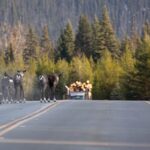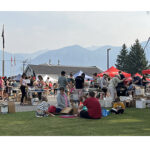Home »

We wanted conservation, we got environmentalism – Part 2
Op-Ed Commentary
In the 1990s Premier Mike Harcourt, leader of the NDP, took note of the evangelistic fervour of environmentalism and toyed with the idea of harnessing this moment for re-election. American politicos were touting consensus-based conflict resolution methodology developed in the United States to quell prison riots. Could this methodology be used to quiet the “War in the Woods?” Harcourt’s minions shaped the idea and chose three parts of B.C.: for a try out.
Stephen Owen, B.C.’s former Ombudsmen, was appointed Commissioner of the Commission on Resources and Environment (CORE). He split the Kootenays into East and West as organizers surmised that the West Kootenay with its many draft dodgers and hippies would never be able to work with working class rancher/logger persons from the East Kootenay.
Eleven East Kootenay interest-based sectors were identified and the land base laid out in polygons. Break out groups consisting of Sector Representatives and their supporters met and began collating areas of interest, agreement and conflict.
At first CORE made good headway. However, as tension between ideologically driven environmentalists and industry escalated political backlash grew. The message I and many others heard Mr. Morrison, (Victoria’s representative) deliver to the East Kootenay CORE table after two years of give and take negotiations was that “because they had only reached consensus on 98% of the land base, (not 100%) the process had failed and therefore the government would take total control of land use planning.”
A new division of Government, the Land Use Co-ordinating Office, (LUCO) would prevail.
You could have heard a pin drop in the room.
But I am getting ahead of myself.
The East Kootenay CORE table had contracted me to write a narrative that would reflect the concerns and recommendations of each of the sectors. This meant sitting through many of the meetings and visiting sector meetings to get a sense of their positions.
Ian Jack, the Chief Park Naturalist at Kootenay National Park was the Conservation Sector representative. Mr. Jack had been instrumental in first raising awareness of and having the Upper Columbia Wetlands protected. He was not seen as someone who would be “taking jobs away” and people in the resource sector understood that compromise was necessary. I believe Mr. Jack thought that if the protection of the environment was going to be a valued notion support would have to come from all sectors.
Most sector representatives were from a tradition of coalition decision-making. Once agreement was reached, likely one that not everyone would be happy with, the agreement would be honoured. It was said half jokingly that “if anyone came away from the table happy then it was not a good agreement!” This saying reflected a Canadian way of resolving public interest conflict. Progress was made and relationships built.
Mid-stream, and to everyone’s surprise, a new sector was added. An argument had been made to the organizers that environmental concerns were under-represented and that this area of interest should have another representative. Therefore, environment portrayed as a sector distinct from conservation was parachuted in and given a seat.
Mr. John Bergenske, its representative, came to the meetings with a crusader attitude. He would rise and make long loud speeches demanding more protected areas be set aside and that resource development be shut down. He argued that we were in environmental crisis! The end was near!
It appeared his goal was to create discord and disrupt the process. He understood that emotions are powerful and predictable drivers of decision-making, that a position presented in an emotional context creates a predisposition to elicit those same emotions again and again. It is a well know tactic that strategic planners use to disrupt meetings.
The forestry sector’s response to this new style of representation was to send in their bulldog, Mr. Dave Melenka. At each reconvening of the table there was now a protracted ideological argument between Mr. Bergenske and Mr. Melenka.
At first this was entertaining but as each of the contestants became more enraptured their speeches became predictable. Their goal-directed emotional speeches were made to exert effects upon judgment and decision-making. I did not understand why the facilitators put up with this disruptive chest beating style but would later realize that they were pleased to see the proceeding’s disrupted.
(It has been noted by Clive James, the admired Australian cultural critic, that an “overlord’s power to bore was a cherished and necessary component of his repressive apparatus.”)
Other sectors were not getting time to express their concerns or make their reports. The spirit of cooperation drained. Participants were either intimidated, impressed or just too darn Canadian, too polite, to tell these guys that they were being obstructive.
The government’s representative, Mr. Morrison, was, I believe, pleased to see CORE derailed.
Government’s authority to call all the shots on B.C. land use had been questioned by the very fact that a Commission was underway. From a bureaucrat’s perspective the sooner this adventure into public participation in land use planning was over the sooner the exploitation of the province through the government’s network of overlapping tenures in partnership with big business and big unions could continue unabated.

The press loved the bravado and chest beating of Mr. Bergenske and Mr. Melenka. Their inflammatory speeches made headlines!
Working people in the East Kootenay who witnessed these displays were getting a whiff of American style activism. Business was being demonized. Business was destroying the planet, stealing from the future, polluting the pristine wildlands, they were greedy and money grubbing. People fought back, a trucker rally was organized for the upcoming CORE meeting in Kimberley. The press covered it in all its’ lurid detail. Even CBC Vancouver was there, imagine all the way from Vancouver!
Mr. Bergenske, leader of the East Kootenay Environmental Society, was going to save us from ourselves. Mr. Melenka declared that environmentalists were putting people in the Kootenays out work, they would destroy the forest industry and people’s livelihood.
Rational discussions around actual on-the-map issues were usurped by prophecies of doom and ego-driven personality conflict. The stuff of tabloids! Well, maybe the bureaucrats were right. The whole process had become too political. Thanks to Mr. Bergenske and Mr. Melenka CORE was about ideology not land use.
The new hero, the bureaucrats and the old guard won. The made in the East Kootenay Land Use Plan died. Mr. Bergenske had his crusade and notoriety, the bureaucrats regained control, and the forest industry would continue to make their plans with government behind closed doors.
Land use planning for all of the province was taken over by the newly created Land Use Coordination Office (LUC0). The East Kootenay Environmental Society or Wildsight as its now known, found other demons to slay, other crusades with which to stir emotions and fund raise.
In my opinion, the deliberate escalation of caustic argument was why CORE’s carefully thought out recommendations were never authorized. The loud protracted arguments undermined both the governments’ and citizens’ faith in consensus-based conflict resolution.
The two per cent not yet agreed upon by CORE enabled the government to tell participants that the made in the Kootenays land use planning process had failed. Better to shut down CORE and put land use planning back into the hands of the bureaucrats. CORE recommendations were put on the back burner and never authorized.
As soon as Mr. Morrison made his announcement that CORE had failed, people began to leave. They felt betrayed. Their time and effort had been wasted. It would be a long time before anyone in the East Kootenay participated in joint land use planning.
What most wanted was conservation, local input into Land Use Planning and innovation; what they got was closed door government planning and permitting, attack style environmentalism and divided communities.
– Peter Christensen is a Columbia Valley based writer and poet








